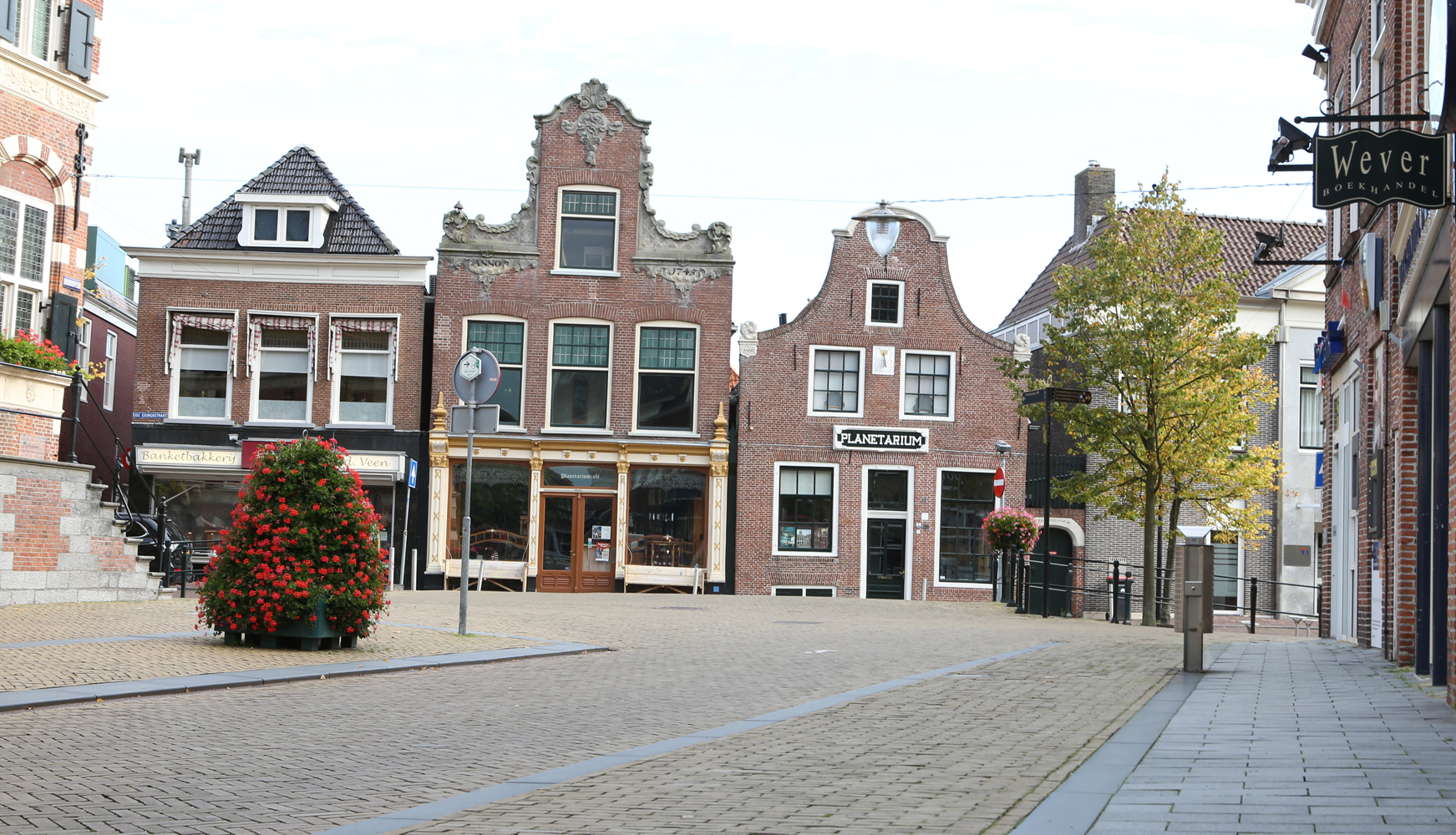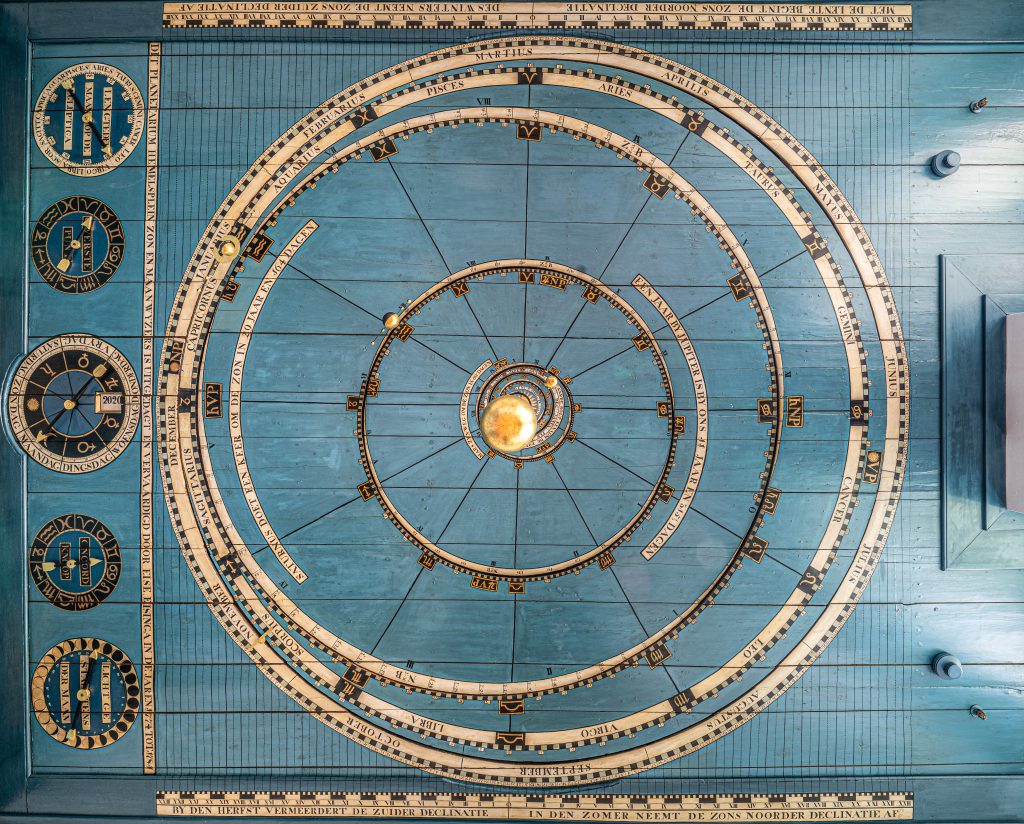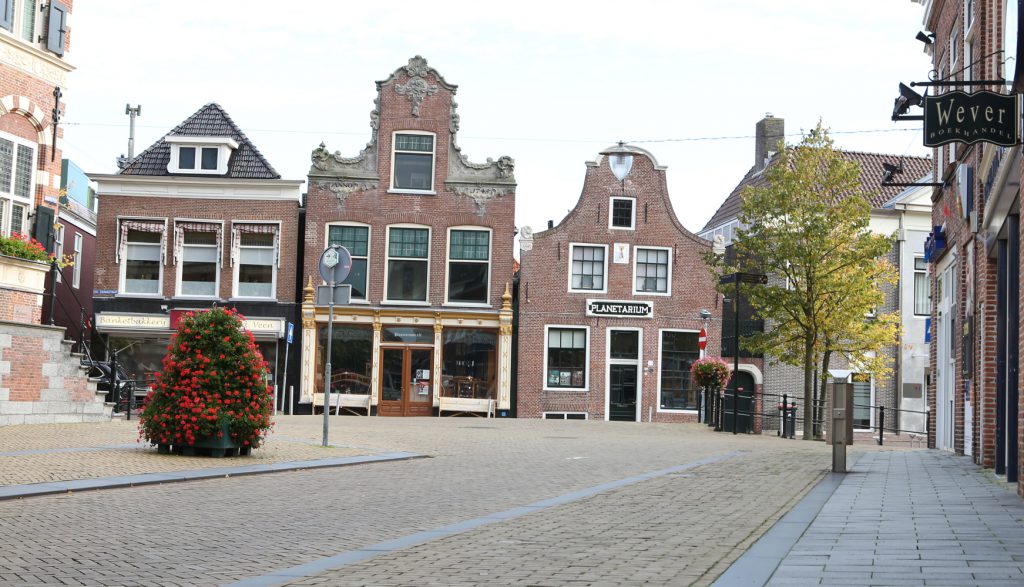Franeker, The Star of the eleven historical cities of Friesland
Franeker is also known as the Star of the eleven historical cities of Friesland. This naturally refers to the famous Eleven Cities Tour, which is organised for ice skaters, cyclists, ramblers and classic car enthusiasts, to name but a few. However, Franeker also boasts the Netherlands’ oldest working planetarium. The Royal Eise Eisinga Museum is probably the best known, and certainly the most impressive museum in Friesland. Stepping inside is tantamount to taking a trip back in time, and you are bound to be amazed by the working model of the solar system suspended from the ceiling of this splendid canalside house’s living room. The planetarium was constructed by Eise Eisinga between 1774 and 1781, and it remains topical to this very day.
Historical city center
Part of the city centre of Franeker is still surrounded by a splendid bulwark, on which its traditional tearooms, or ‘tea houses’ are situated. Sights to see on a walking tour of the traditional city centre include splendid canals and numerous historic buildings, such as the Dutch Renaissance Town Hall, the mediaeval Martinikerk church, and Martenastins castle, which dates from 1498 and currently houses the Martena Museum.
History
The surrounding of Franeker has a long and rich history. There are findings of artifacts that date back to 500 BC. In this period the first terps were built. These are man made mounds or knolls and were built to be safe from the floods. Before there were any dykes, most villages were built on small patches of dry land, surrounded by marshes. Today, one can see many dykes in the landscape, the Slachtedijk is well known.
Sightseeing in Franeker
The centre of Franeker, once a university city, has several tremendous historical buildings, but you can find these also in the surrounding villages. Franeker has also a recently reconstructed shopping area with a mixture of attractive stores.
Royal Eise Eisinga Planetarium
The Eise Eisinga Planetarium in Franeker is the oldest planetarium in the world that still works. It was designed and constructed by woolcomber and amateur astronomer Eise Jelteszoon Eisinga between 1774 and 1781. He decided to build the planetarium to show that a particular constellation of the planets would not cause the end of the world. At the time, the public was very concerned by that. Eisinga wanted to show how the Solar System really works, and that there was no reason to fear a cosmic catastrophe. The Planetarium is very well preserved, and in 2006 it celebrated its 225th anniversary. Queen’s Commissioner E.H.T.M. Nijpels of Friesland had the honour to give the Planetarium the title ‘royal’ on behalf of Queen Beatrix of The Netherlands. More information: www.planetarium-friesland.nl/en
Museum Martena
Franeker was a university city between 1585 and 1811. In Museum Martena there is a big collection of countless artifacts that reminds of this period in the history of Franeker. For example, one can find there the Senaatskamer, with many paintings of the professors that taught the students. The Museum also has contemporary expositions. Behind the museum is the Martena garden. In the months during spring, many people enjoy the rare species of plants that grow there.
Martenatuin
Jaarlijks brengen honderden mensen een bezoek aan de tuin om de speciale stinzenplanten te bewonderen. Sommigen zijn uniek, omdat ze nergens anders in Nederland voorkomen. De van oorsprong uitheemse planten zijn door kruisridders, kooplieden en andere reizigers meegenomen en in de stinzentuinen geplant. De Martenatuin is in de 18e eeuw aangelegd en in het voorjaar op zijn mooist, als de stinzenplanten volop in bloei staan. De tuin is tijdens winkeltijden en op zaterdag gratis te bezoeken. In de zomermaanden worden er beelden tentoongesteld in de tuin. De Martenatuin is een stinzentuin stammend uit het einde van de vijftiende eeuw. De bekende tuinarchitect Roodbaard was waarschijnlijk verantwoordelijk voor de herinrichting van 1830 in de Engelse landschapsstijl. De aanplant van stinzenflora stamt uit die periode, maar mogelijk zijn sommige stinzenplanten al voor die tijd door kooplieden en andere reizigers meegenomen. In 1972 is de imposante Martenatuin hersteld. Ook nu is de Martenatuin nog steeds een echte stinzentuin door de grote rijkdom aan soorten: winterakoniet, sneeuwklokje, lenteklokje, voorjaarshelmbloem, holwortel, anemoon, breed longkruid, bostulp, knikkende vogelmelk, aronskelk, gewone vogelmelk, daslook en kievitsbloem.
Kaatsmuseum
Friesland’s number one sport is kaatsen, or Frisian handball. The sport might sound unfamiliar, but there are at least 50 other countries in the world where it is played.Since Medieval times the sport was played in Friesland. The Kaatsmuseum opened in 1972 and it is the oldest sportsmuseum in The Netherlands. There is a large collection of prizes and attributes that play a role in the game. The museum is located on the Voorstraat.
The Cityhall
Franeker was a wealthy city during the 16th and 17th century, and the cityhall shows that. The building consists of two sections, one built between 1591 and 1595 and a second built in 1760. The oldest one was in use until 1997, nowadays it is used for weddings and official receptions. The unique leather wallpaper covered with goldleaves, found in the council- and weddinghall, is made in rococo-style. The cityhall can be found at the Raadhuisplein 1 and is open for visiting between 13.30 and 17.30. Several other historical buildings and sightseeing locations can be found in the surrounding villages.
The Corncarriershouse
This building from the year 1934 can be found at the Zilverstraat 28 in Franeker. Here, all the grain, beers and wines were checked and from here transported. There is a permanent exhibition for viewing in the building.
The Martinichurch
The Martinichurch in Franeker is located in the middle of the terp at the Breedeplaats. It is not exactly known when the church was built, probably in the 15th century. It is known, however, that there has been a church already at the same place in the year 1085. In the current church there is wood cutting dating from the 15th and 17th century. Impressive are the, mostly undamaged, 490 gravestones from the 16th to 18th century.





